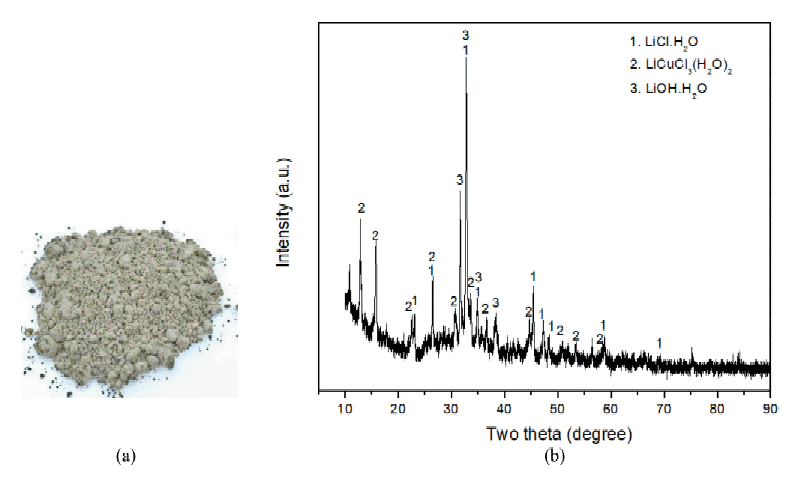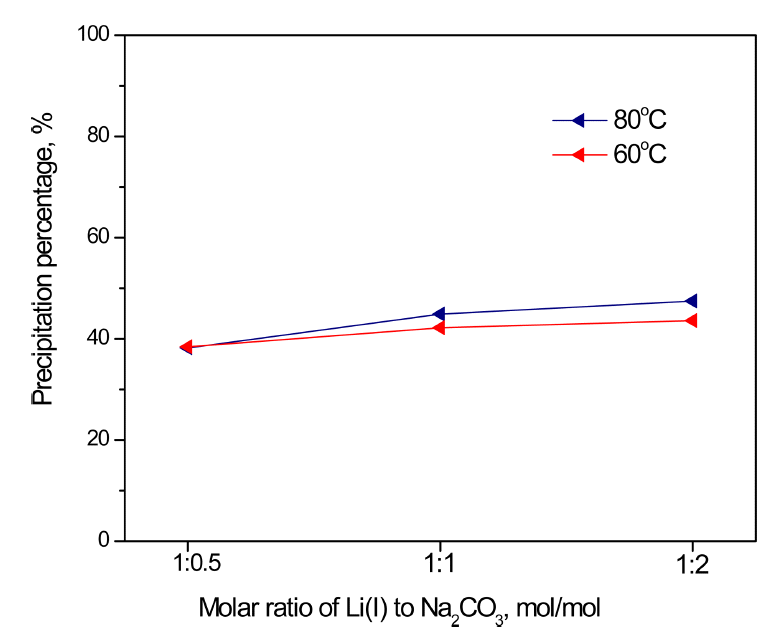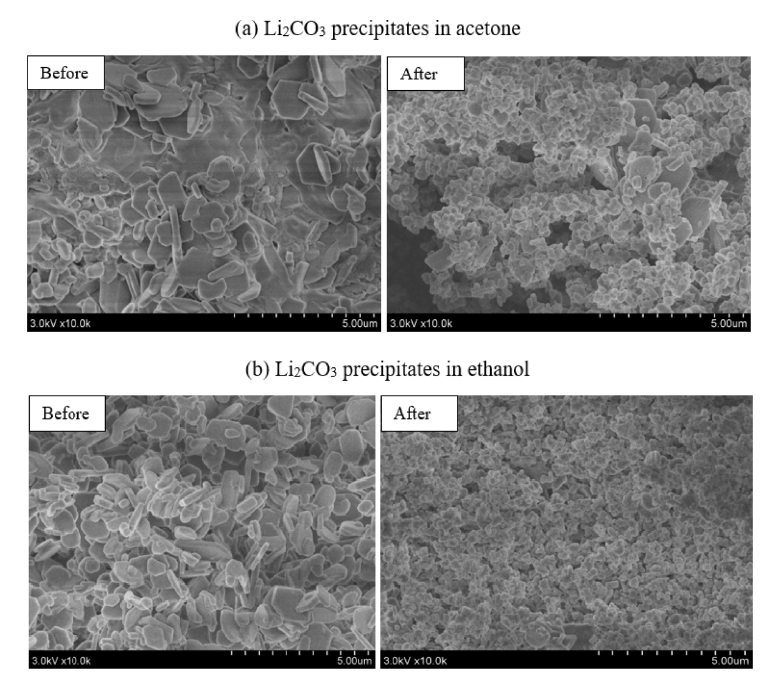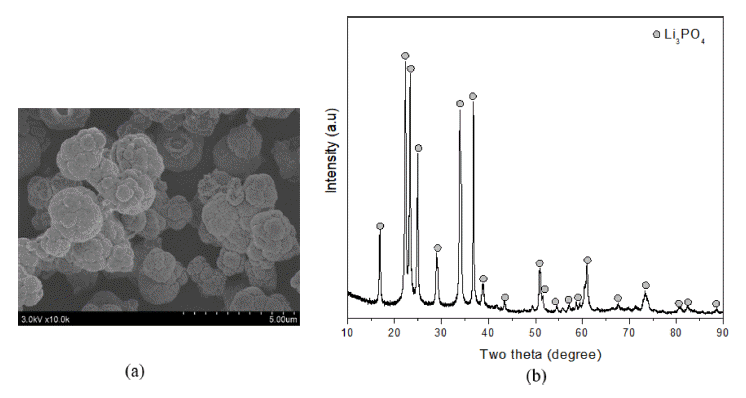Recovery of High-Purity Lithium Compounds from the Dust of the Smelting Reduction Process for Spent Lithium-Ion Batteries
Article information
Abstract
The recovery of valuable metals such as cobalt, nickel, and lithium from spent lithium-ion batteries (LIBs) has attracted much attention. In this study, a hydrometallurgical process for the recovery of high-purity lithium compounds like Li2CO3 and Li3PO4 from dust containing Li, Co, Ni, Cu, Fe, Mn, and Si produced during the smelting reduction of spent LIBs was investigated. The separation of Li over other metals from the dust was achieved by two methods. The first method was to leach metals from the dust with distilled water and then to precipitate the dissolved metal ions from the leaching solution at pH 10. The second one was to mix the dust with solid NaOH, following the dissolution of the mixture with distilled water. Optimum conditions for the second method were a 1:0.17 weight ratio of dust to NaOH, 50 g/L pulp density for 120 min at 22oC. These two methods resulted in a solution containing only Li(I) and Na(I). The precipitation of Li(I) to Li2CO3 from the leaching solution by Na2CO3 with the addition of acetone or ethanol was optimized a 1:0.5 molar ratio of Li(I) to Na2CO3, 6:5 volume ratio of solvent to Li(I) solution for 30 min at 22oC. Under the optimum conditions, the precipitation percentage of Li(I) was higher than 92.0% with above 99.0% purity. Additionally, using Na3PO4, 97.1 % Li(I) was precipitated from the leaching solution to Li3PO4 with 93.1% purity. An optimized process for the recovery of lithium compounds from the dust is proposed.
1. Introduction
Lithium (Li) with its unique characteristics, including high reactivity, light weight, low density, and rechargability has been used in batteries, ceramics and glass, chemical additives, pharmaceuticals, polymer, lubricating grease, air treatment, and other applications [1-3]. In recent years, the annual worldwide growth rate for lithium products has been about 20% [4,5]. Lithium carbonate (Li2CO3) and lithium hydroxide (LiOH) have accounted for 60% and 23% of the total lithium supply, respectively [6]. The weight percentage (5-7%) of lithium in lithium-ion batteries (LIBs) together with the growing demand for LIBs are the reason for this remarkable increase [7,8]. Currently, about 80% of the total amount of lithium is produced by Australia and Chile from lithium-rich natural resources like brine or minerals [6]. However, the possibility of lithium shortages could occur in the future due to its high demand and gradual depletion of its high-grade sources. Therefore, the recovery of lithium from secondary resources can be considered an effective solution to meet the demands for this metal as well as sustainable production.
Spent LIBs are considered to be a good secondary resource, containing valuable metals such as Co, Ni, Cu, and Li [9-11]. Hydrometallurgical and pyrometallurgical methods or their combination have been extensively used for the recovery of metals from the spent LIBs [12-14]. During the smelting reduction treatment of spent LIBs, valuable metals such as Co, Ni, and Cu are reduced and concentrated to metallic alloys, while Li and Al are separated into slag. Some of the Li(I) is found in the dust during this treatment [15].
Considering the shortage of Li(I) compounds, it is necessary to recover the Li(I) in the slag and dust. The composition of the dust from the smelting reduction of spent LIBs depends on the temperature of the smelting reduction. Unlike the slags, the dust contains Co, Cu, Fe, Mn, and Ni together with Li. Therefore, it is important to recover the Li present in the dust. Another problem is related to the precipitation of lithium carbonate from aqueous solutions containing Li(I). In general, the precipitation of Li2CO3 from aqueous solutions by adding Na2CO3 needs high energy consumption and releases a large amount of wastewater [16-18]. As another approach, Li(I) can be precipitated to lithium phosphate (Li3PO4), which has lower solubility than Li2CO3 and is a potential electrolyte for application in LIBs [19,20]. Yet, the precipitation of Li(I) from the solution containing sodium ions is still challenging. Therefore, it understood that further studies are needed for the recovery of pure lithium compounds from the spent LIBs.
In this work, a hydrometallurgical process was investigated to recover high-purity Li(I) compounds from the dust which results from the smelting reduction of spent LIBs. The dust contained Li, Co, Ni, Cu, Mn, Fe, and Si. While Co, Cu, Fe, Ni, and Mn are precipitated as hydroxides in the aqueous solution, Li(I) does not precipitate owing to its hydrolysis characteristics [21]. Therefore, utilizing this fact, Li(I) can be separately recovered from the dust by leaching and precipitation. Leaching conditions such as solution pH and pulp density were investigated to recover pure Li(I) solution from the dust.
To manufacture high-purity Li(I) compounds such as either Li2CO3 or Li3PO4 from the recovered Li(I) solution, several methods were investigated, such as the addition of either acetone or ethanol to the solution, and the molar ratio of the precipitants to the solution at room temperature. The characteristics of the Li2CO3 and Li3PO4 precipitates were analysed by XRD and SEM measurement. From the obtained results, a process for the selective recovery of high-purity Li (I) compounds from the dust is proposed.
2. Experimental section
2.1 Chemicals
Chemical reagents such as sodium carbonate anhydrous (Na2CO3, Daejung Chemical & Metals Co., >99.0%, Korea), sodium phosphate tribasic anhydrous (Na3PO4, Daejung Chemical & Metals Co., >99.0%, Korea), and sodium hydroxide (NaOH, Daejung Chemical & Metals Co., >97%, Korea) were used without any purification. Acid solutions like hydrochloric acid (Daejung Chemical & Metals Co., 35%, Korea), nitric acid (Daejung Chemical & Metals Co., 60%, Korea) and sulphuric acid (Daejung Chemical & Metals Co., >95%, Korea) were prepared by diluting corresponding concentrated acids with doubly distilled water. Organic solvents such as acetone (Daejung Chemical & Metals Co., >95.0%, Korea) and ethanol (Daejung Chemical & Metals Co., >95.0%, Korea) were used without any purification.
2.2 Material characteristics
The dust provided by a company in Korea was grey in colour, fine, and had hygroscopic property (Fig 1a). X-ray diffractometer measurement (XRD, X’Pert-PRO, the Netherlands) confirmed that lithium mainly existed in the form of chloride salts (see Fig 1b). The presence of LiOH in the dust was observed, which could be ascribed to the hygroscopicity of the dust. The composition of the components in the dust was determined by the complete dissolution of some amount of the dust by an aqua regia solution. The concentration of metals in the resulted leaching solution was measured by ICP-OES (Inductively coupled plasma-optical emission spectrometry, Spectro Arcos, Cleve, Germany). As presented in Table 1, Li, Cu, and Mn were the major metal components of the dust, together with a small amount of Co, Ni, Fe, and Si. The sum of weight percentage of the metals was lower than 100%, indicating that some water existed in the dust because of its hygroscopic property.
2.3 Leaching and precipitation procedures
Leaching experiments were carried out using solutions with desired pH values in a 250 cm 3 three-neck round bottom flask. The weight ratio of solid to the volume of leaching solution (pulp density, g/L) was fixed at 20 g/L except when investigating the effect of pulp density. Experiments were performed at room temperature (22±1 °C) with 300 rpm stirring speed for 120 min, controlled by a magnetic stirrer (WiseStir MSH-20D, Daihan Scientific Co., Korea). The concentration of metal ions in the leaching solution was measured by ICP-OES. The leaching efficiency of metals from the dust was calculated as:
where mi is the mass of a metal in the dust before the leaching and ma is the mass of the metal in the aqueous solution after the leaching, which was obtained from the ICP-OES measurement.
Precipitation experiments were performed by slowly adding precipitants such as Na2CO3 or Na3PO4 into the leaching solution containing Li(I) (each 20 mL) and the mixtures were stirred at room temperature. When needed, an organic solvent like acetone or ethanol was added into the reaction mixture with the desired volume of solvent. After the required time, the precipitates of Li(I) were collected by filtration. The precipitation percentage of Li(I) was calculated as:
where mLi and mLi* are the mass of Li(I) in the aqueous solution before and after the precipitation.
Li2CO3 purification. Li2CO3 precipitates were mixed with distilled water (20 mL) and stirred for 10 min. Then, acetone or ethanol was slowly added into the mixture with a volume ratio of unity. The mixture was stirred for 30 min. The precipitates were filtrated and dried in an oven at 80 °C overnight. The characteristics of the precipitates before and after the purification was measured by XRD measurement and high resolution scanning electron microscopy (HR-SEM, SU-70, Hitachi, Japan). The purity of the precipitates was verified by dissolving them in 1.0 mol/L H2SO4 solution and then the concentration of Li(I) was analysed by ICP-OES measurement. The pH value of the aqueous solutions was measured by Orion Star thermal scientific pH meter (model A221, USA). Experiments were duplicated with errors within ±5%.
3. Results and discussion
3.1 Leaching
3.1.1 Effect of solution pH
The XRD data confirmed that lithium and copper in the dust existed as LiCl and CuCl 2. Hence, it could be anticipated that other metals in the dust might also exist in the form of metal chlorides such as CoCl2, NiCl2, and MnCl2, FeCl2, and FeCl3. As is shown in Fig 2, Co(II), Ni(II), Cu(II), Mn(II), Fe(II), and Fe(III) are precipitated at certain pH. Therefore, the leaching efficiency of these five metals significantly depends on the pH value of the leaching solution. To investigate the effect of solution pH on the leaching of the components from the dust, the initial pH of the leaching solutions was varied from 2 to 10. Fig 3 shows that Li was completely leached in the investigated pH ranges, whereas iron was not dissolved at all. The leaching percentage of Co, Ni, and Mn were about 69.8, 72.4, and 65.4% irrespective of the initial solution pH. Meanwhile, the leaching percentage of Cu decreased from 57.5 to 29.3% and that of Si increased from 15.2 to 23.2% as initial pH increased from 2 to 10. The final pH values of the leaching solution after the completion of the reaction were in the range of 4.9 to 5.2, which was ascribed to the hydrolysis of dissolved metal ions in the aqueous solution. Since no iron was leached in these experiments and the precipitation of Fe(II) hydroxides occurs around pH 6, it can be said that the iron in the dust exists as FeCl3 and was precipitated as Fe(III) hydroxides [22].
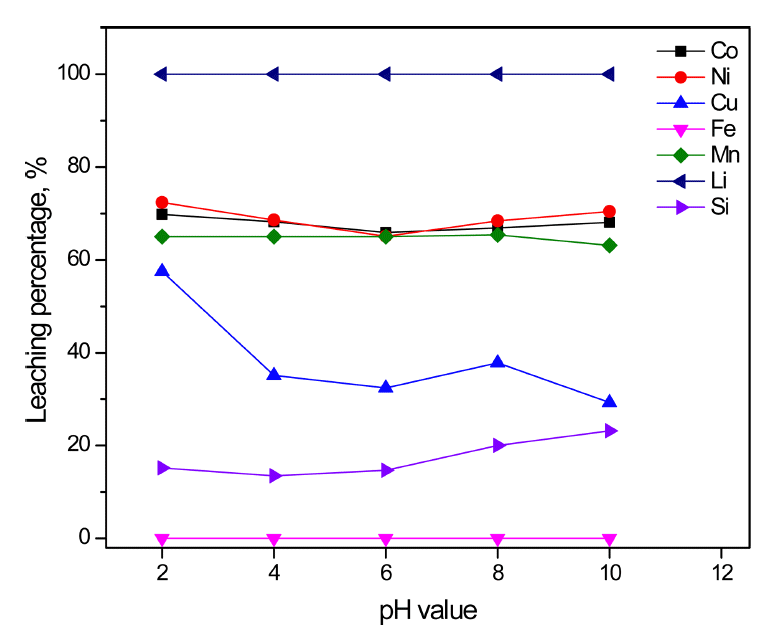
The effect of pH value on the leaching of metals from the dust. Experimental conditions: 20 g/L pulp density at 22°C for 120 min.
When the initial solution pH is in the range of 2 to 10, the metal chlorides are first dissolved from the dust and at a certain pH the dissolved ions form metal hydroxides, which depends on the concentration of the metal ions and chloride ions in the leaching solution. Since the effect of initial pH on the leaching efficiency of Li(I) from the dust was negligible, distilled water (pH ~ 6.5) was selected for further studies. The leaching reaction of the metals from the dust by water can be written as:
3.1.2 Effect of pulp density
In order to investigate the effect of pulp density on the selective leaching of Li(I) from the dust, pulp density was varied from 20 to 50 g/L. Experiments were performed at room temperature for 120 min. In Fig 4, the leaching percentage of Co, Ni, and Mn was in the range of 61.7 to 72.2% and that of Si was from 18.6 to 20.4%. The leaching percentage of Cu slightly decreased from 33.7 to 27.6%, while no Fe was leached with increasing pulp density. It was noticeable that Li was completely dissolved from the dust under the experimental conditions.

The effect of pulp density on the leaching efficiency of metals from dust by distilled water at 22°C for 120 min.
From the obtained results, 50 g/L pulp density was selected for the leaching of Li(I) from the dust. The concentration of the metal ions in the leaching solution is presented in Table 2. To recover Li(I) over others from the dust, selective precipitation of the other metal ions except Li(I) is necessary.
3.1.3 Separation of Li(I) from the leaching solution and dust
Precipitation of metal ions over Li(I) from the leaching solution
The concentrations of Co(II), Ni(II), Cu(II), Mn(II), Li(I) and Si(IV) in the leaching solution were 278.6, 374.0, 789.2, 1525.8, 3514.5, and 54.0 mg/L, respectively. To selectively recover Li(I), the pH value of the leaching solution was adjusted to either pH 8 or 10, where the metal ions such as Co(II), Ni(II), Cu(II), and Mn(II) would be precipitated as metal hydroxides such as Cu(OH)2, Co(OH)2, Mn(OH)2 and Ni(OH)2 owing to their low solubility (see in Table 3). Meanwhile, Li(I) ions would remain in the solution due to the high solubility of Li(I) compounds in the aqueous solution (12.8 g/100 mL for LiOH and 83.2 g/ 100 mL for LiCl at 20 °C) [21,23]. Our experimental data revealed that the complete precipitation of Co(II), Ni(II), Cu(II), Mn(II), and Si(IV) was obtained at pH 10, while Li(I) stayed in the filtrate. It was noticeable that Si(IV) from the leaching solution was also separated together with the metal hydroxide precipitates. The removal of Si(IV) could be ascribed to the adsorption of Si(IV) species like Si(OH)4 and SiO(OH)3- to metal hydroxide precipitates through hydrogen bonding [24]. Thus, the selective separation of Li(I) over others from the leaching solution was obtained by adjusting the solution pH to 10. This method consists of two steps, namely leaching of dust with distilled water and then the precipitation of the dissolved divalent metal ions by increasing the solution pH to 10.
In order to reduce the number of steps for the recovery of Li(I) from the dust, mixing of the dust with solid NaOH was attempted to maintain the solution at high pH during the leaching reaction, which can lead to the precipitation of the dissolved divalent metal ions during the leaching.
The selective leaching of Li(I) from the mixture of the dust and solid NaOH
To investigate the effect of mixing solid NaOH on the selective leaching of Li(I) from the dust by distilled water, the weight ratio of the dust to solid NaOH was varied from 1:0.1. This ratio was selected based on the stoichiometry of the precipitation reaction between metal ions such as Co(II), Ni(II), Cu(II), and Mn(II) as presented in Table 2, and NaOH. Experiments were fixed at 50 g/L pulp density at room temperature for 120 min. Our results indicated that Li(I) was completely leached when the weight ratio of the dust to solid NaOH was 1:0.17, while no metal ions and Si(IV) were detected in the leaching solution. In addition, the effect of reaction time, from 30 to 150 min on the selective leaching of Li(I) over other metals was also considered with the weight ratio of the dust to solid NaOH at 1:0.17 and 50 g/L pulp density. In Fig 5, the leaching percentage of Li(I) slightly increased from 96.1 to 100%, while other metals and Si(IV) were not detected in the investigated ranges. These results demonstrated that the selective separation of Li(I) over others from the dust was obtained by one step leaching. The optimum conditions for the selective leaching of Li(I) over others from the mixture of the dust and solid NaOH by distilled water were a weight ratio of dust to solid NaOH of 1:0.17 with 50 g/L pulp density for 120 min. Under these optimum conditions, concentration of Li(I) and Na(I) in the leaching solution were 3514.5 and 5606.1 mg/L, respectively and the final pH of the leaching solution was 10.4.
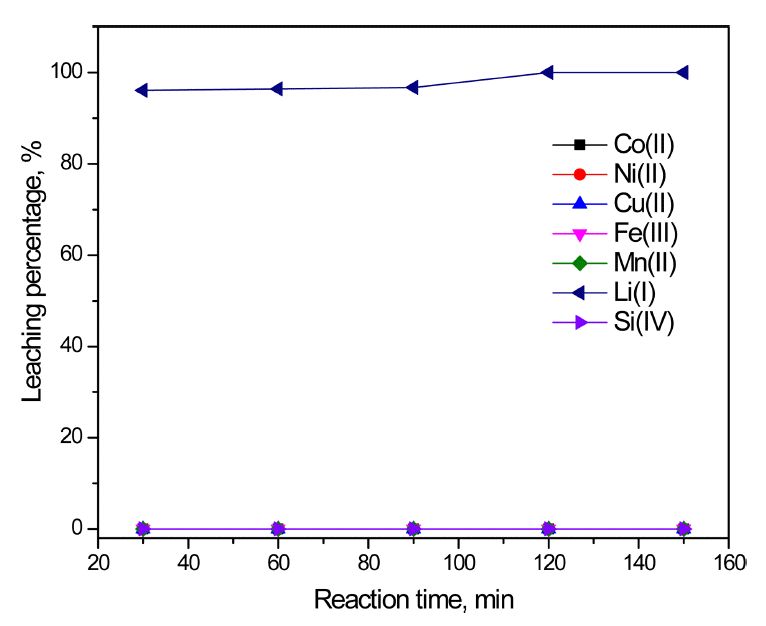
The effect of reaction time on the leaching of Li(I) from dust by distilled water at 22°C. Leaching conditions: 1:0.17 weight ratio of the dust to solid NaOH, 50 g/L pulp density.
There are two methods that can be used to recover a pure Li(I) solution from dust. In the first, the dust is leached by distilled water and then the divalent metal ions are separated by precipitating the divalent metal ions by increasing the solution pH to 10. In the second, the dust is mixed with solid NaOH and this solid mixture is treated by distilled water. The hydrolysis reaction of metal ions in the aqueous solution accompanies a decrease in solution pH. This makes it necessary to increase the solution pH to a certain value in order to separate all the divalent metal ions from the solution. Comparing the two methods, the latter method is simple and can be applied to a commercial operation.
3.2 Precipitation
3.2.1 Precipitation of Li2CO3 from the leaching solution using Na2CO3
To test the performance of recovering Li(I) from the leaching solution, Na2CO3 was added as a precipitant to convert Li(I) to Li2CO3. The concentrations of Li(I) and Na(I) in the leaching solution were 3514.5 and 5606.1 mg/L, respectively. The molar ratio of Li(I) to Na2CO3 was varied from 1:0.5 to 1:2.0. Reactions were performed at 60 and 80 °C for 120 min. As shown in Fig 6, the precipitation percentage of Li(I) was below 50% under the studied conditions. This can be explained by the solubility characteristics of the Li2CO3 precipitates in the aqueous medium (Ksp = 2.0×10-4 at 60 °C and Ksp = 8.9×10-5 at 80 °C) [25]. Although increasing the concentration of Na2CO3 or the reaction temperature can increase the precipitation of Li2CO3, the complete precipitation of Li(I) to Li2CO3 would be difficult to obtain [26].
3.2.2 Precipitation of Li2CO3 from the leaching solution by Na2CO3 while adding organic solvents
Effect of volume ratio of solvent to Li(I) leaching solution
Precipitation from a solution is related to the dielectric constant of the solution. When the dielectric constant of a solution can be decreased, the degree of precipitation can be increased. Therefore, to increase the precipitation of Li(I) from the aqueous leaching solution, in this work either acetone or ethanol was added to the solution during the precipitation of Li(I) by Na2CO3.
The effect of the volume ratio of solvent to Li(I) solution on the precipitation percentage of Li(I) was investigated from 1:5 to 8:5. The molar ratio of Li(I) to Na2CO3 was fixed at unity. Reactions were carried out at room temperature within 120 min. The results (see Fig 7) showed that the precipitation percentage of Li(I) remarkably increased from 72.0 to 92.8% for ethanol and from 73.9 to 95.0% for acetone as the volume of organic solvents was increased. The difference in the precipitation percentage of Li(I) by acetone or ethanol was insignificant (below 3.0%), which can be ascribed to the small difference in their dielectric constant (acetone = 21.01, ethanol = 24.6, and water = 80.2) [27]. The accompanying decrease in the dielectric constant of the solution with the addition of acetone and ethanol is responsible for the increase in the precipitation percentage of Li(I). From these results, the volume ratio of the solvent to Li(I) solution was fixed at 6:5.

The effect of volume ratio of organic solvents to Li(I) solution on the precipitation percentage of Li(I) from the leaching solution with 1:0.5 molar ratio of Li(I) to Na2CO3 at 22°C for 120 min.
Effect of molar ratio of Li(I) to Na2CO3
To increase the percentage of Li(I) precipitation from the leaching solution, the molar ratio of Na2CO3 to Li(I) was tested from 1:0.5 to 2:1, while keeping the volume ratio of the solvent to the Li(I) solution at 6:5. The reactions were done at room temperature for 120 min. Our results showed that the precipitation percentage of Li(I) in acetone and ethanol negligibly increased (below 2.0%). This indicated that complete precipitation of Li(I) by Na2CO3 is difficult to obtain.
Effect of reaction time
The effect of reaction time on the precipitation of Li(I) from the leaching solution was investigated from 30 to 180 min. The molar ratio of Li(I) to Na2CO3 and the volume ratio of the solvent to Li(I) solution in the experiments were fixed at 1:0.5 and 6:5, respectively. In Fig 8, the reaction time insignificantly affected the precipitation percentage of Li(I) by the two solvents (about 92.0% for ethanol and 95.0% for acetone) when reaction time was increased from 30 to 180 min. These results indicate that the precipitation reaction of Li(I) by Na2CO3 in the presence of organic solvents is fast.
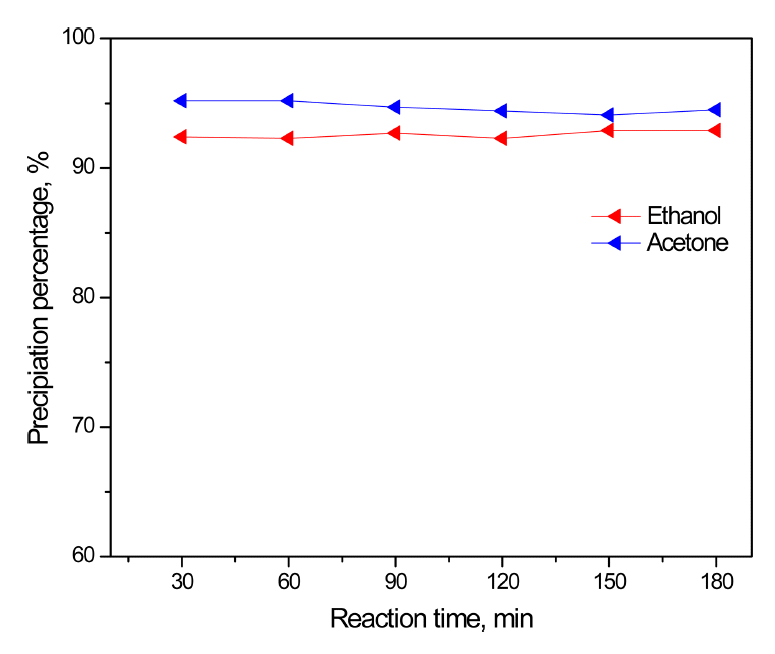
The effect of reaction time on the precipitation of Li2CO3 from the leaching solution with 1:0.5 molar ratio of Li(I) to Na2CO3 and 6:5 volume ratio of solvents to Li(I) leaching solution at 22°C.
From the obtained results, the optimum conditions for the precipitation of Li(I) from the leaching solution by Na2CO3 with the simultaneous addition of either acetone or ethanol were 1:0.5 molar ratio of Li(I) to Na2CO3, 6:5 volume ratio of the solvent to Li(I) solution with 30 min reaction time at room temperature. Under the optimum conditions, the precipitation percentage of Li(I) from the leaching solution was 95.2% for acetone and 92.4% for ethanol. The purity of the Li2CO3 precipitates in acetone and ethanol were 59.7 and 96.0%, respectively.
The presence of Na(I) in the leaching solution at high concentration coupled with the fast precipitation kinetics of Li2CO3 can cause the inclusion of Na(I) in Li2CO3 precipitates, resulting in a decrease in the purity of the precipitates. To recover Li2CO3 with high purity, the Li2CO3 precipitates were washed in a mixture of water and acetone or ethanol, which can release Na(I) to the solution. Our obtained data indicated that the mixture of water and solvent with a volume ratio of unity increased the purity of Li2CO3 precipitates to 99.3% for acetone and 99.5% for ethanol. These results were also confirmed via the XRD diffractogram of Li2CO3 precipitates in the two solvents before and after the washing, which showed the disappearance of some peaks in the XRD diffractogram after the washing step (see Fig 9). Therefore, the removal of Na(I) ions as a contaminant from the Li2CO3 precipitates was achieved by using the mixture of water and solvents.

XRD patterns of Li2CO3 precipitates before and after washing with the mixture of water and (a) acetone and (b) ethanol. (Volume ratio of water to solvent was unity).
The morphology of the Li2CO3 in acetone and ethanol was analysed by SEM (see Fig 10). The recovery percentage of Li(I) from the leaching solution after the precipitation and washing was 91.6% for acetone and 85.2% for ethanol. In order to increase the recovery percentage of Li(I) from the solution, some more work is needed. The solvents after the process can be purified by fractional distillation [28,29].
3.2.3 Precipitation of Li3PO4 from the leaching solution using Na3PO4
Since the solubility product of Li3PO4 in water is very low (Ksp = 3.2×10-9 at 25 °C), precipitation of Li(I) from the leaching solution was tried by adding Na3PO4 as a precipitant, without adding the organic solvents. Reactions were done at room temperature for 30 min with the molar ratio of Li(I) to Na3PO4 at unity. Our experimental result indicated that the precipitation percentage of Li(I) was 97.1%. The chemical formula and morphology of the Li3PO4 precipitates were confirmed by XRD and SEM measurements (see Fig 11). The purity of Li3PO4 was 93.1%. The recovery efficiency and purity of Li3PO4 can be increased by increasing the amount of the precipitant and purification by washing.
Considering the precipitation percentage and the purity of the precipitates, recovery of Li(I) as Li3PO4 from the solution looks more efficient than that of Li2CO3. However, compared to Li3PO4, Li2CO3 has several advantages as a precursor for the synthesis of important commercial products like Li2O or LiOH due to its thermal decomposition characteristics [28]. Thus, the precipitation of Li(I) to Li2CO3 from the leaching solution is still the first choice for the recovery of Li(I) from dust.
3.4 Integrated procedure
From the obtained results, a process for the recovery of Li(I) from dust produced by the reduction smelting of spent LIBs can be proposed (see Fig 12). Initially, dust resulting from the heat treatment of spent LIBs is mixed with solid NaOH and then the mixtures are leached by distilled water. By this leaching, only Li(I) exists in the leaching solution, while other components of the dust like Co, Cu, Fe, Mn, Ni and Si are removed from the solution. These leaching residues can be the raw materials for the smelting reduction operation. Li(I) can be recovered from the leachates by adding Na2CO3 as a precipitant for Li2CO3 together with acetone or ethanol. Finally, the precipitated Li2CO3 can be purified by washing with a mixture of acetone and distilled water. This process allows the effective recovery of Li(I) from the dust in the form of Li2CO3 with high purity. The use of organic solvents in the precipitation of Li(I) can lower the large amount of wastewater disposal as well as energy consumption, compared with the precipitation of Li(I) from pure aqueous medium. Since this process consists of leaching and precipitation, this process can be applied in a real operation for the recovery of Li(I) from spent LIBs.
4. Conclusions
During the smelting reduction of spent LIBs, dust containing Li and other metallic components of LIBs (Co, Cu, Fe, Ni, Mn, and Si) is produced. A hydrometallurgical process was developed to recover pure lithium compounds like Li2CO3 and Li3PO4 from this dust. The separation of Li over Co, Ni, Cu, Fe, Mn, and Si from the dust was achieved by first leaching with distilled water and then precipitating the metal ions except for Li(I) at pH 10. One step leaching of the mixture of the dust and solid NaOH with distilled water also resulted in a leaching solution containing only Li(I). The optimum conditions for the complete leaching of Li(I) were a 1:0.17 weight ratio of dust to solid NaOH, and 50 g/L pulp density for 120 min at room temperature. The addition of either acetone or ethanol together with Na2CO3 to the solution containing Li(I) enhanced the precipitation of Li(I) from the leaching solution. Optimum conditions for the solvent precipitation of Li(I) were a 6:5 volume ratio of solvent to Li(I) solution, a 1:0.5 molar ratio of Li(I) to Na2CO3 at room temperature for 30 min. The precipitation percentage of Li(I) was higher than 92.0% and the purity percentage of Li2CO3 precipitates was above 99.0%. The precipitation percentage of Li(I) to Li3PO4 using Na3PO4 in the aqueous solution was 97.1% with 93.1% purity. From the obtained results, a process for the recovery of pure lithium compounds from the dust was proposed.
Acknowledgements
This work was supported by the Technology Innovation Program (Development of Material Component Technology) (Project number: 20011183) funded by the Ministry of Trade, Industry & Energy (MOTIE, Korea).
